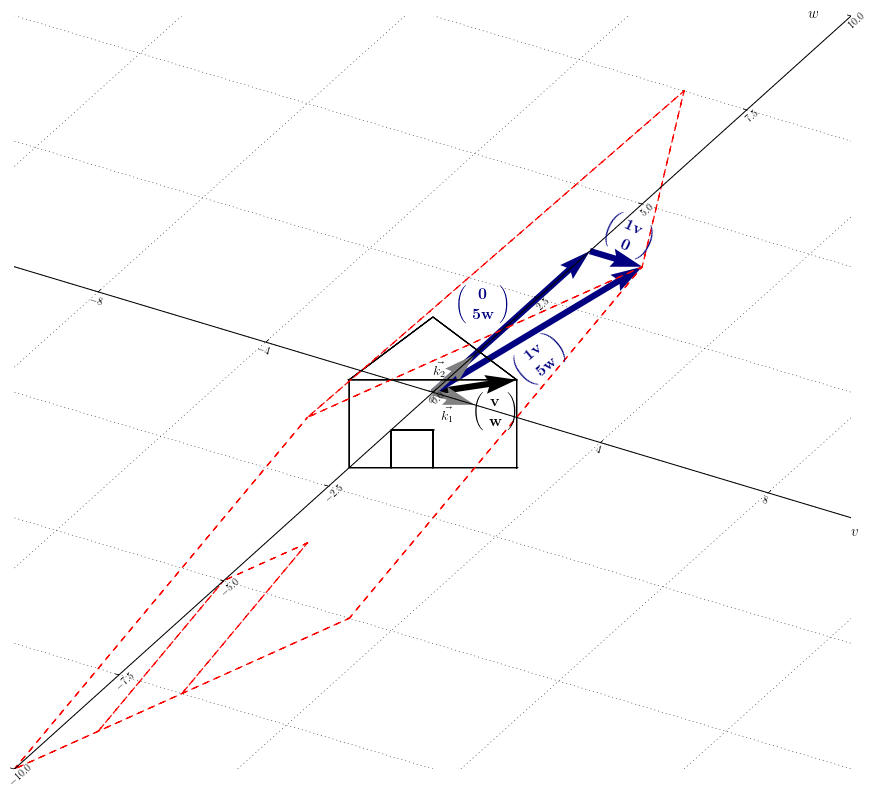1. Analogy
Let’s assume that we’d like do a numerical processing in the best suited base on this purpose.
Let’s have an example : we’d like to divide an even number by $2$. It turns out that the base 2 is the best suited base for doing that. Indeed a simple shift from left to right does that processing.
We have the three following steps :
- Change of basis (from decimal to binary)
- We do the processing in that new base (shift)
- Change of basis (from binary to decimal)
Example I
Let’s divide $208$ by $16$.
Let’s proceed the above steps discussed :
- Conversion of $208$ into the base 2 :
11010000 - 1st shift :
01101000. 2nd shift :00110100. 3rd shift :00011010. 4th shift :00001101 - Conversion of
00001101into the decimal base : $13$
2. Calculation
A diagonalizable matrix $A$ is decomposed as follows :
In $(1)$ $P$ is the eigenvectors matrix of $A$ and $D$ the eigenvalues matrix of $A$.
In our analogy of above, the calculation of $A\vec{x}$ would be the numerical processing. We then have in $(1)$, from right to left :
- Conversion of $\vec{x}$ in a new basis, becoming $\vec{x}’$
- Processing the linear transformation in the new basis : $D\vec{x}’=\vec{y}’$
- Conversion of $\vec{y}’$ in the starting basis, becoming $\vec{y}$
Example II
Let $A=\left( \begin{smallmatrix} 2 & 1 \\ 3 & 4 \end{smallmatrix} \right)$. Let’s diagonalize $A$.
We determined the eigenvectors of $A$ in the dedicated chapter (let $\beta=1$).
Then $P=\left( \begin{smallmatrix} 1 & 1 \\ -1 & 3 \end{smallmatrix} \right)$ and $P^{-1}= \frac{1}{4}\left( \begin{smallmatrix} 3 & -1 \\ 1 & 1 \end{smallmatrix} \right).$ The matrix of the eigenvalues is : $D=\left( \begin{smallmatrix} 1 & 0 \\ 0 & 5 \end{smallmatrix} \right)$.
The diagonalization of $A$ is thus :
3. But more concretely ?
The point of the diagonalization is to proceed the linear transformation in a more suited basis. This new basis is composed of the eigenvectors and turns to be a new axis system.
This reduces the calculation amount, since in the new basis, $\vec{y}’$ is obtained by multiplying by a factor $\lambda_i$ the components of $\vec{x}$ for each axis independently from one another. Figure 12.1 shows the linear transformation of the example II in the new basis : $D \underbrace{ \left( \begin{smallmatrix} v \\ w \end{smallmatrix} \right) }_{\vec{x}’}
= \underbrace{\left( \begin{smallmatrix} 1v \\ 5w \end{smallmatrix} \right)
}_{\vec{y}’}$.

Recapitulation
The diagonalization proceeds a basis change . Only if they exist and form a basis, the eigenvectors become the new basis.
A diagonalizable matrix $A$ is decomposed as follows :
Each eigenvalue in $D$ must stand in the same column than the related eigenvector in $P$.
$D$ is a diagonal matrix. Since the elements outside of its diagonal equal zero, $D$ acts on each axis independently from one another, which reduces the calculation amount.